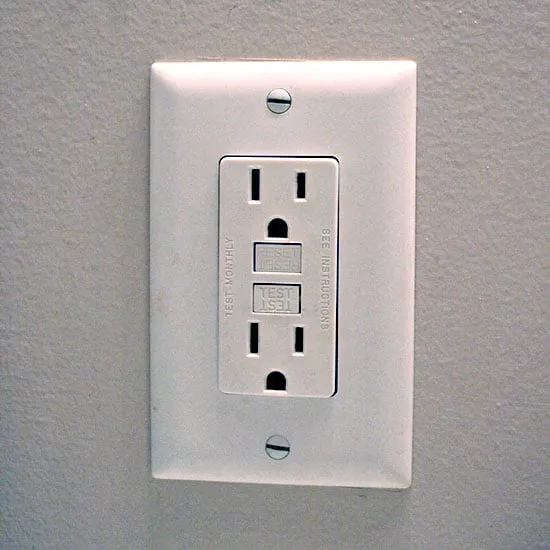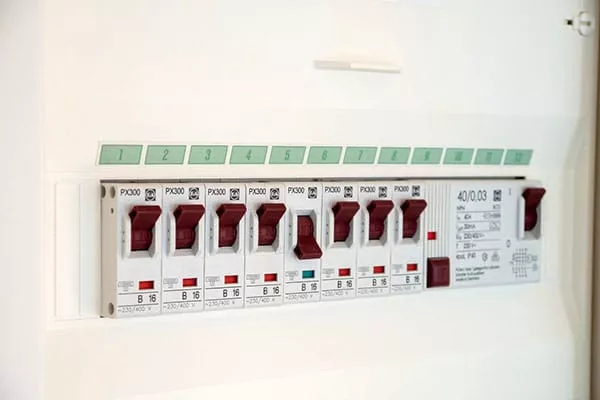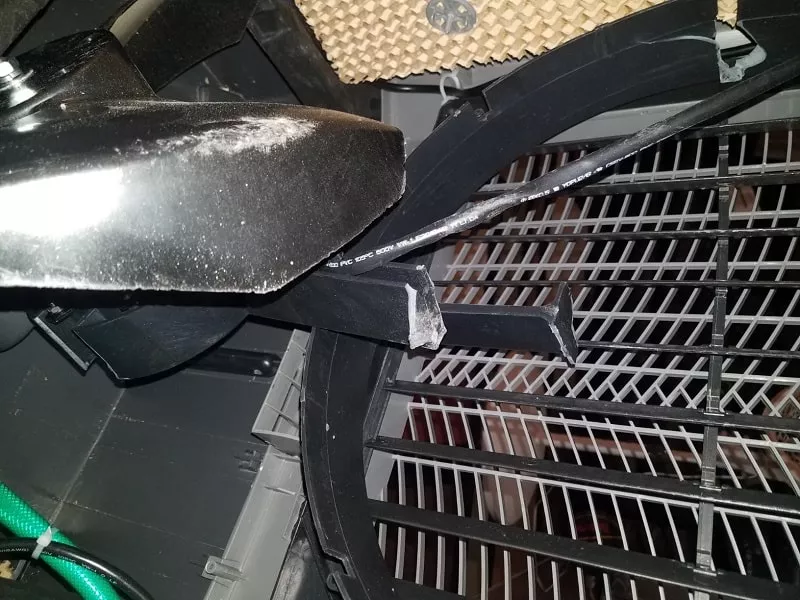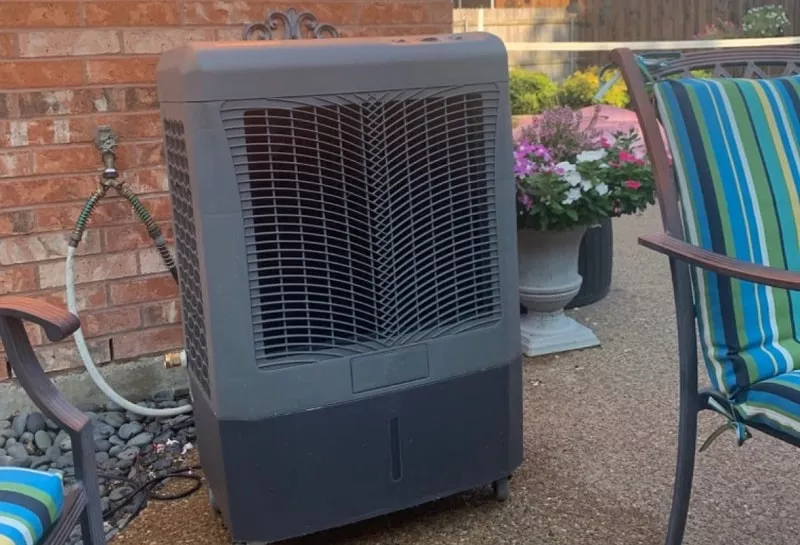Your evaporative cooler is not turning on? In this article, you’re getting a complete list of things you should inspect before you declare your evaporative cooler dead.
We’re going to check the most common issues and their fixes. And along the way, you’re going to learn a bunch about the inner workings of your cooler.
Quick answer: An evaporative cooler won’t turn on if it does not receive electric power. This could be due to a broken wall outlet, power cord, or blown fuse. But broken parts such as blown electronics, water damage, or an empty water tank can also stop your evaporative cooler from turning on.
There are many different causes. And even more fixes. So, let’s dive right in.
7 Causes and fixes for an evaporative cooler not turning on
Many things can break in an evaporative cooler.
However, if your evaporative cooler doesn’t even turn on, you can boil down the possible broken parts to just those few that can impact the power supply.
Either a broken part prevents electric power from reaching other components of your swamp cooler. Or a broken part absorbs all of the power because it is broken.
To get your evaporative cooler running again, we have to check your entire power supply chain (from fuses to wall outlet to cooler fan) together.
Let’s have a look:
1. Broken power cord or extension cord
The first thing to check is your evaporative cooler’s power cord. And, if you use one, also the extension cord.
Power cord issues usually occur when your swamp cooler is older and you frequently move it around.
Over time, the bending and twisting wear down the power cord. It’s just a matter of time until you get a loose contact somewhere in the cable.
So, check your power cord.
How to test
There are multiple ways to test for a broken power cord or extension cord.
To check a broken power cord, you have to plug it in the wall outlet. If you can unplug the power cord from the evaporative cooler, you are lucky!
In this case, you can use a multimeter (or any form of voltage meter) to check whether there is a voltage on the power cord.
If you can measure a voltage, then try moving the cord around, and measure again in different positions. Is there any position where your power cord carries no voltage?
If you don’t have a multimeter, then you can also plug your power cord into your evaporative cooler, switch the “ON”-switch on, and then move the evaporative cooler around. Also, wiggle the power cord close to both ends around.
If there is a loose contact, your evaporative cooler will turn on for a split second.
If you can’t unplug your power cord from your evaporative cooler, then you have to open your evaporative cooler’s case. Inside the cooler, check for any voltages directly on the electric circuit boards, or on the connection point where the power cord is soldered to the internal circuitry.
If you can measure your wall outlet’s voltage somewhere in the cooler, your power cord is fine.
Testing for a broken extension cord is simpler. Just plug your evaporative cooler directly into a wall outlet (without the extension cord).
If it works without the extension cord but not with it, then your extension cord is broken.
How to fix
If you notice that your power cord is broken, get a replacement cord either online or in an electronic hardware store.
Alternatively, find any broken or unused electronic appliance around your house and repurpose its power cord ( …so, yes, just cut it off ).
If the power cord of your evaporative cooler has a plug, then cut that plug off. Then connect and solder it to the new replacement power cord.
Else, if it doesn’t have a plug and connects directly to the internal electronics, then replace the existing power cord by unsoldering it and soldering the new cord in place.
Now you have a new power cord and your evaporative cooler should turn on again!
You can easily replace a broken extension cord by buying a new one.
Evaporative coolers use very little power. Even large units rarely use more than 400 Watts.
The reason is that the most power-hungry component is the built-in fan. And fans use very little power.
For comparison, I have a very strong floor fan, which was sold as an industrial wind machine. It uses 120W.
So, most evaporative coolers use less than that.
Any extension cord can handle that. Even the cheapest ones. Assuming an average power consumption of 100W, it will draw only 1.2 Amps of current.
All extension cords are rated above that. This 13 Amps extension cord (click here to view it on amazon) is more than enough.
2. Wall outlet defective
Another reason your evaporative cooler is not turning on is that the wall outlet is not powered.
Sometimes wall outlets break and stop carrying power.
Luckily, that’s easy to troubleshoot and work around.

How to test
Plug any other device into the wall outlet you normally use with your evaporative cooler. I recommend just plugging in your phone with the phone charger.
Does the wall outlet work?
To double-check, you can carry the evaporative cooler to another wall outlet and plug it in there.
Does it turn on now?
If the original wall outlet doesn’t work, even with another device, and your evaporative cooler turns on with another wall outlet, then your wall outlet is defective.
For some reason, it carries no power.
On the other hand, if the wall outlet works with another device and your evaporative cooler doesn’t turn on, even on another wall outlet, then the wall outlets are fine and the power issue is somewhere inside your cooler.
How to fix
I recommend having a professional fix your wall outlet. But if you’re familiar with wall outlets, or at least you don’t have two left hands and you are willing to learn something, then you can replace your wall outlet with a new one.
You can buy replacement wall outlets in any hardware store, or, of course also online.
Before you get to fix your wall outlet, you can run your evaporative cooler off another wall outlet!
3. Tripped circuit breaker or blown fuse
Your wall outlet looks fine but there is no power on it? Maybe it’s just a blown fuse or a tripped circuit breaker.
Fuses and circuit breakers are protection mechanisms. They protect your home’s electric circuit from carrying too high currents, which can cause overheating, and, eventually, house fires.
If your evaporative cooler doesn’t turn on, it might just be a blown fuse of a tripped circuit breaker.
Let’s check it together.
 Check your electric service panels for out-of-place switches.
Check your electric service panels for out-of-place switches.
How to test
To see whether one of your fuses or circuit breakers blew, go to your home’s electric service panel.
There, you see multiple rows of switches which are the circuit breakers.
Also, check the fuses inside your electric service panel. Fuses are these glass tubes with a thin metal wire inside.
In one or more of them, you might not be able to see any wire. Or you see a wire, but it’s broken. Those are the blown fuses!
How to fix
Check, if all of the circuit breakers are switched on.
If one of them is out of place, then switch it to match the state of the others.
Usually, you can find current ratings on your fuse (e.g. 15 Amps or 20 Amps).
Replace the broken fuses with matching replacement fuses.
If you are not sure which amperage your fuse has, then buy a 15A replacement fuse. Better cut off electricity too early than too late.
4. Empty water tank
Evaporative coolers always need soaked water pads to produce cold air. Usually, when the water pads are dry, your cooler will turn on, but it will act as a regular fan, just blowing air (instead of blowing cold air).
Depending on the design of the electric controls a pump may or may not turn on automatically to refill the pads.
However, in some (honestly rare) cases, it may be that your evaporative cooler doesn’t turn on at all when the built-in water tank is empty.
How to test
Refill the water tank and see if it turns on.
If your evaporative cooler turns on with a full water tank, then it likely has a sensor that’s measuring water levels.
Also, check the user manual for whether there’s a warning light indicating a low water level.
 In some evaporative coolers, you can connect a water line directly, so there’s no need to manually refill a tank
In some evaporative coolers, you can connect a water line directly, so there’s no need to manually refill a tank
How to fix
Depending on the evaporative cooler model you have, there are two possible fixes.
The first fix for empty water tanks is, obviously, manually refilling them.
But some evaporative coolers can be attached to an external water pump or to a tap. The cooler then refills automatically.
Most coolers with built-in water tanks, however, don’t have a connection point for an external water source. That’s why they have a built-in water tank in the first place.
So, in most cases, you have to refill the water manually.
5. Broken part in electronic circuitry
Evaporative coolers have built-in electronic parts, such as a power module and a thermostat.
Sometimes these parts can break. Evaporative coolers are especially prone to electronic issues since they contain water.
So, one frequent problem in evaporative coolers is water damage. Water can short-circuit parts on the electronic circuit boards.
But some electronic parts can break on their own. Electronic manufacturers usually test the circuitry they produce.
But sometimes a part that’s out of tolerance goes unnoticed. Tolerance issues are very hard to detect.
In the long run, out-of-tolerance parts either break down themselves or cause other parts to break.
How to test
The easiest way to test for broken electronics in an evaporative cooler is a visual inspection.
Disassemble your cooler until you can access the electronic circuitry.
Then, using a lamp and a magnifying glass inspect the electronics for a few minutes. Usually, when there’s an error you can see it after a couple of minutes of staring at the circuitry.
You should look out for burn marks, stains, and broken-off pieces. Sometimes (although this happens rarely) you can also see parts “hovering” one of their ends above the solder joint without connecting to it.
How to fix
If you find a broken part, replace it with a matching replacement part. You can find replacements online or in a hardware store.
For most through-hole-technology (THT) components, you can find equivalent replacement parts by looking for matching color codes (for resistors) or matching the ratings printed on the case of the part.
It’s harder to replace broken surface-mounted-device (SMD) components that are soldered onto a circuit board’s surface (without going through any holes).
These are usually very small and don’t have any ratings or color codes. But you can find a matching SMD part on the circuit board and measure its resistance, inductance, and capacity. This way, you know which replacement part to buy.
To replace the parts you usually have to use a soldering iron.
6. Stuck or broken fan
When the fan inside your evaporative cooler is stuck or broken, it changes its electrical properties.
A moving fan converts most of the input power to kinetic (movement) energy.
A stuck fan, on the other hand, usually is a short circuit, because all of the electric power passes through it without being converted to movement.
So, an issue in your fan can cause your entire evaporative cooler to not turn on.
 A broken part can cause the fan to stop rotating
A broken part can cause the fan to stop rotating
How to test
To test for a stuck or broken fan in your cooler, open the case and inspect the fan.
Try to rotate it manually. Is it hard to turn? If it is, then there might be an issue with the bearings.
Also, check whether something external blocks the movement of the blades. For example, when a plastic part is stuck between the fan blades, it stops the fan from moving.
A third possible cause could be dust that blocks the fan.
How to fix
In most cases, evaporative cooler fans last for a long time and bearings are not the case. So, make sure your fan is free of dust and any other parts blocking the movement.
If your fan doesn’t rotate easily, try adding a silicone lubricant such as WD-40.
Only if it still does not rotate, consider replacing the fan with a new one.
To replace the fan you need to be lucky. Usually, evaporative coolers have custom-built fans. They are not standardized such as computer fans.
I’d suggest contacting the manufacturer for a replacement fan.
7. Thermostat setting is too high
The thermostat inside your evaporative cooler controls all the other components (including the pump and the fan).
If your evaporative cooler does not turn on at all, the thermostat obviously doesn’t turn on as well.
But if your evaporative cooler turns on (which you can tell by lights or a display turning on), then the reason for it not doing anything might be the thermostat setting.
An evaporative cooler only turns on when the target temperature (which you set on the cooler’s front panel) is below your current room temperature.
Only then, it makes sense for the thermostat to turn on the fan.
So, it might just be that you have to decrease the thermostat settings.
How to test
Check the temperature reading on your front panel. If there is none, check the power knob.
How to fix
To fix your thermostat not turning on, lower the temperature. If it still doesn’t turn on, the issue is likely somewhere else.
What to do if your evaporative cooler still doesn’t turn on?
Evaporative coolers are very durable devices. And they rarely break to the point that you don’t even get them to turn on.
There are very few moving parts in an evaporative cooler. Essentially, it’s just a fan. And some coolers also have a built-in pump.
But that’s it.
Usually, the simpler a device is, the longer it works. And evaporative coolers are supposed to work for at least a decade.
So, if your evaporative cooler doesn’t turn on, I’d say you either got really unlucky and somehow water spilled onto the electronics, or the manufacturer messed up.
In both cases, I recommend just getting a new quality evaporative cooler.
I always recommend this Hessaire evaporative cooler(click here to view it on amazon).
It’s battle-tested and is the most purchased evaporative cooler in the US.
So, you can rely on that one.
I admit it’s more expensive than other coolers. And it looks bulky. But it’s well worth the price.
It’s a one-off higher expense for 10 years of worry-free cooling.
Conclusion
The list of problems and fixes in this article should help you troubleshoot (and hopefully fix) your evaporative cooler not turning on!
If you can’t get it working even after hours of investigating possible issues, or if you don’t have the electronic knowledge to troubleshoot it, then I recommend just getting a new cooler.
Quality evaporative coolers are not cheap. But instead of wasting your free time trying to desperately fix things, you can just free yourself and get a new cooler.
